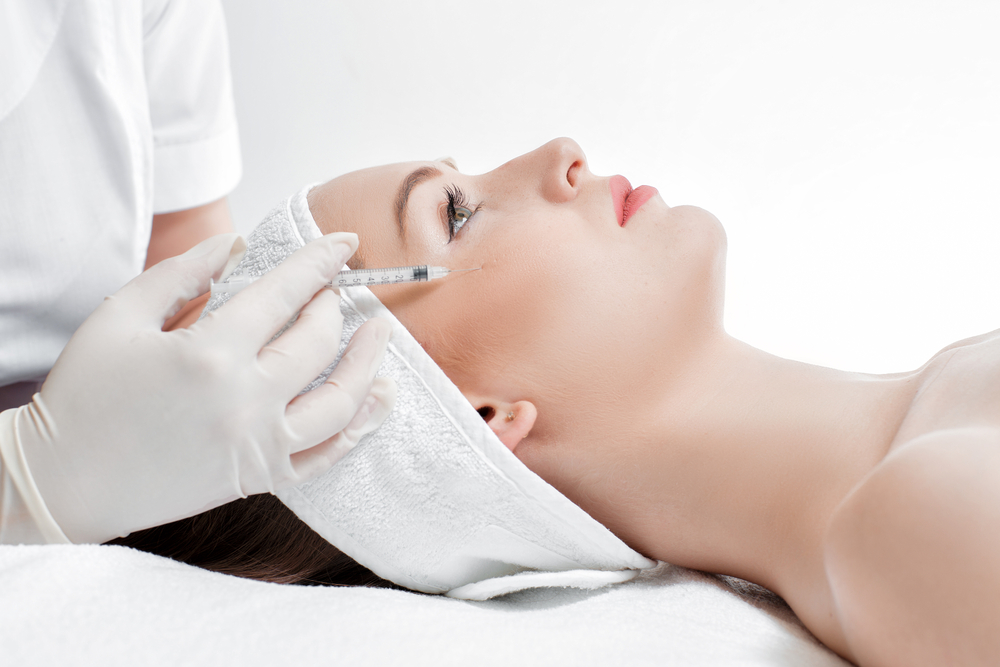About
- Sculptra is a dermal filler and its active ingredient is Poly-L-Lactic acid.
- It works by stimulating the body to produce new collagen.
Injection Sites
- Sculptra is FDA-approved for treatment of smile lines and other facial wrinkles.
- Off-label applications include butt lifts and correction of cellulite and elbow & knee wrinkles.
Safety & side effects
- Redness and swelling are common after treatment and usually go away on their own.
- Sculptra is considered a safe treatment with a low risk of serious side effects.
Results
- Effects last up to two years.
Cost
- $600-1000 per vial.
- Number of vials needed depends on injection site, skin condition, and age.
Providers Near You
- You can find a nearby Sculptra provider using our cosmetic doctor search tool.
What Is Sculptra?
Sculptra is an injectable dermal filler that can treat wrinkles and correct age-related volume loss in the face. It has been in use worldwide since 1999.
The active ingredient in Sculptra is Poly-L-Lactic acid (PLLA). This is a biocompatible, biodegradable substance that can stimulate collagen synthesis by cells in the skin called fibroblasts.
With aging, natural collagen in the skin weakens and breaks down, giving rise to wrinkles. This is more obvious in the face. PLLA reverses this process by making more collagen and strengthening the collagen that’s already there. Not only does this better correct wrinkles, but it also adds volume.
Sculptra received its FDA approval in 2004 as a treatment for lipoatrophy (thinning of the fat pads of the face) associated with HIV and AIDS. It received an additional FDA approval in 2009 as a cosmetic agent for the correction of facial wrinkles.
Areas Treated with Sculptra
The official FDA documentation notes that Sculptra is approved for the treatment of nasolabial folds and other facial wrinkles.
This includes:
- Nasolabial folds or smile lines, which are the folds running between the nose and mouth.
- Marionette lines, which are folds that run from the mouth corners down to the chin.
- Chin wrinkles.
- Filling hollow temples.
Non-surgical butt lift or buttock augmentation
Some plastic surgeons recommend Sculptra for non-surgical butt lifting, particularly for people who aren’t surgical candidates or don’t want to deal with the post-op downtime. This is not an FDA-approved indication for Sculptra.
Most patients require 10+ vials for Sculptra buttock augmentation and some need as many as 40 vials. On average, a Sculptra butt lift costs $8,000-12,000.
>>To learn more, read our article on a Sculptra butt lift
Cellulite
This is another off-label use for Sculptra. Sculptra is injected under the dimpled areas of cellulite, plumbing them up to the same level as the surrounding skin. For better results, some physicians combine Sculptra with Cellfina, an FDA-approved cellulite treatment.
Sculptra may produce good results in cellulite but is not considered a first-line treatment option. More common cellulite treatments include subcision (the technique used in Cellfina), Thermage, and laser treatments.
Elbow and knee wrinkles
Sculptra can be used to smoothen elbow and knee wrinkles. However, treatments like Thermitight and microneedling produce superior results.
What to Expect with Sculptra
How is Sculptra injected?
- Before you receive the injection, you will either get a topical anesthetic or Sculptra will be combined with an anesthetic to help with the discomfort from the injection.
- Sculptra is injected into the deep layer of the skin (dermis).
- The treatment area is massaged to spread the product evenly.
- The session takes 30-60 minutes including prep time.
Sculptra aftercare
- You will be able to go home right after the treatment session.
- In the 24 hours after the session, you can apply ice packs to the area to help reduce the swelling.
- Avoid rigorous physical activity and direct sunlight until the initial swelling subsides.
- You can apply makeup a few hours after the treatment.
- Massage the treatment area following the “three fives” rules–five minutes, five times a day, for five days.
What does massaging Sculptra do?
Massaging helps spread the product evenly under the skin, smoothing over any irregularities that may form. Not massaging may cause the material to clump in one area and create lumps.
Sculptra Results
When does Sculptra show results?
| Immediately after treatment | The injected area appears fuller due to the water content in the injection; this goes away in a few days |
|---|---|
| After two weeks | Swelling should go down. Little to no change at this point |
| After four weeks | Some subtle improvements |
| After eight weeks | Final results begin to appear at this point |
The reason the effects are gradual, unlike regular fillers, is that Sculptra works by stimulating your body to make new collagen rather than immediately volumizing the area with the injected material.
How long does Sculptra last?
Results may last as long as two years. One study conducted at University of Texas Southwestern showed that 80% of people were satisfied with the results 25 months after their last injection.
Complications & Side Effects:
Side effects following Sculptra treatment may include:
- Redness
- Tenderness
- Pain
- Bleeding
- Itching
- Bumps
How often do Sculptra lumps occur?
Being left with permanent lumps after a Sculptra treatment is very unlikely nowadays, however, it was more common in the early days of the product. Newer formulations of Sculptra and more clinical experience with it have drastically reduced the chances of this occurring.
How to get rid of Sculptra lumps?
Massaging will reduce the risk of lump development. If they do appear, they will usually go away on their own.
If a lump develops and does not go away, consult your physician.
Can I get permanent damage from Sculptra?
The chance of experiencing severe side effects or permanent damage from Sculptra is minimal. If you experience any prolonged discomfort, pain, bleeding, lumps, or a rash, call your doctor.
How Much Does Sculptra Cost?
A number of factors can influence the final cost of your Sculptra treatment:
Price per vial/syringe
- One vial of Sculptra costs anywhere between $600 and $1,000.
Number of vials
- For facial treatment, most people need three to six vials of Sculptra.
Number of treatment sessions
- The number of treatment sessions required varies from person to person. On average, three sessions spread over a period of three to four months are needed to produce good results.
Degree of correction needed
- People who are older and those with particularly saggy or wrinkly skin will likely need more injections and treatment sessions, driving the total cost up.
Area of body treated
- When Sculptra is used to cover larger body surface areas, like Sculptra butt lift, a significantly higher number of vials or syringes are usually required.
Sculptra vs. Radiesse
Sculptra is often compared to Radiesse as they both stimulate natural collagen production by the body. Most traditional fillers are based in hyaluronic acid, a substance that directly creates a filling effect.
| Sculptra | Radiesse | |
|---|---|---|
| Effect | Stimulates collagen production | Adds volume like a traditional filler (main effect); May stimulate collagen production (weaker effect) |
| Main ingredient | Poly-L-Lactic acid | Calcium hydroxylapatite |
| Results appear… | After weeks to months | Immediately |
| Results last… | Up to two years | Up to 18 months |
| Cost | $600-1,000 per vial | $600-800 per syringe; $900-1,500 per treatment session on average |
Choosing between Sculptra and Radiesse depends on what your goals are. If your priority is longer-lasting results, Sculptra may be better for you. If you prefer immediate results, Radiesse is the clear winner.
FAQs
Is Sculptra dangerous?
Sculptra is considered a very safe treatment. Most people will experience some redness, swelling, and discomfort but very few will experience serious side effects.
Can Sculptra be dissolved?
No. Poly-L-Lactic acid, the active component in Sculptra, does not have a reversal agent.
Are Sculptra results immediate?
No. Sculptra takes weeks to months to produce results.
Can Sculptra migrate?
Migration is very unlikely with Sculptra. Massaging the treatment area can help spread the material evenly and decrease the risk of migration or lump formation even further.
Is Sculptra different from Botox?
Sculptra and Botox work in completely different ways. Botox temporarily paralyzes facial muscles that produce wrinkles, while Sculptra works by stimulating production of new collagen by the body.
Who should not use Sculptra?
If you have a tendency to form keloid or hypertrophic scars, or if you have an allergy to any of the components of Sculptra, you should avoid it. If you have a skin infection or inflammation near the treatment area, you should wait for it to clear before getting the treatment.
Takeaway
Sculptra Aesthetic is a nontraditional dermal filler that stimulates the body to make new collagen. The results take weeks to months to appear and last up to two years.
Sculptra is FDA-approved for the treatment of facial wrinkles, including smile lines. Off-label uses include the Sculptra butt lift and the treatment of cellulite, as well as elbow and knee wrinkles.
If your goal is long-lasting correction of facial wrinkles or adding extra volume and you don’t need the results to appear overnight, Sculptra may be a good option for you.
Find a Sculptra Provider near You
If you think Sculptra might be right for you, a consultation with a cosmetic doctor will help you make a decision and answer any more questions you may have.
Meet our Medical Review Team and get expert opinions on Sculptura.









